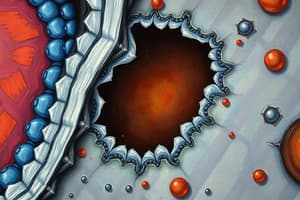Podcast
Questions and Answers
Which of the following is the smallest unit of life?
Which of the following is the smallest unit of life?
- Organ
- Tissue
- Organ system
- Cell (correct)
What is the function of Ribosomes in a cell?
What is the function of Ribosomes in a cell?
- To produce ATP
- To provide structural support
- To synthesize proteins (correct)
- To store genetic information
Which of the following is not a part of the digestive system?
Which of the following is not a part of the digestive system?
- Liver
- Stomach
- Lungs (correct)
- Pancreas
What is the function of Mitochondria in a cell?
What is the function of Mitochondria in a cell?
Which of the following is not a type of blood vessel in the human body?
Which of the following is not a type of blood vessel in the human body?
Biology chapter 2 focuses on the study of ______ in living organisms
Biology chapter 2 focuses on the study of ______ in living organisms
In class 12, students learn about the process of ______ and how it contributes to genetic diversity
In class 12, students learn about the process of ______ and how it contributes to genetic diversity
The study of ______ is important in understanding the classification and evolutionary history of living organisms
The study of ______ is important in understanding the classification and evolutionary history of living organisms
Flashcards
What is a cell?
What is a cell?
The smallest, fundamental unit of life.
Ribosomes function
Ribosomes function
Synthesize proteins.
Mitochondria function
Mitochondria function
Produce ATP.
What is taxonomy?
What is taxonomy?
Signup and view all the flashcards
What is meiosis?
What is meiosis?
Signup and view all the flashcards
Study Notes
Cell as the Basic Unit of Life
- Cell: The smallest unit of life.
- Ribosomes: Function to synthesize proteins.
- Mitochondria: Responsible for cellular respiration, producing energy (ATP) for the cell.
Human Body Systems
- Digestive System: Responsible for breaking down food into nutrients the body can absorb.
- Blood Vessels: Include arteries, veins, and capillaries.
Biology and Genetics
- Biology Chapter 2: Focuses on the study of cells in living organisms.
- Class 12 Biology: Includes the study of meiosis, the process of cell division that leads to the formation of gametes (sperm and egg cells), contributing to genetic diversity.
- Taxonomy: The study of classification and evolutionary history of living organisms.
Studying That Suits You
Use AI to generate personalized quizzes and flashcards to suit your learning preferences.



